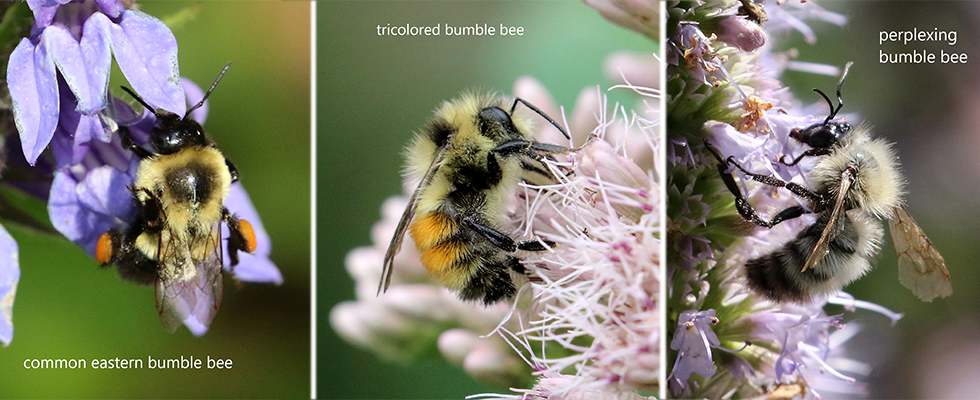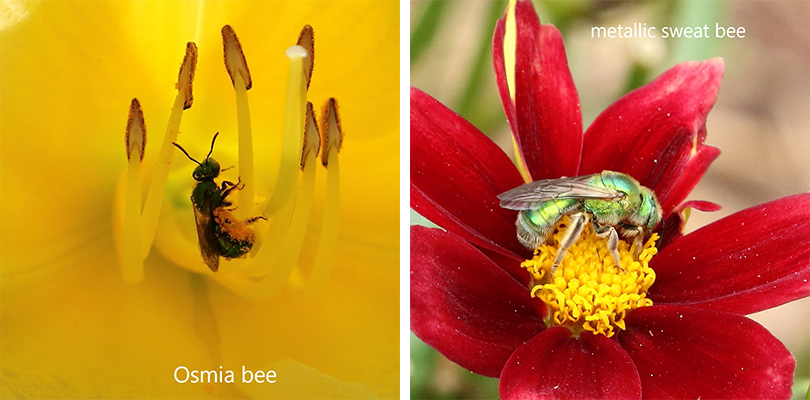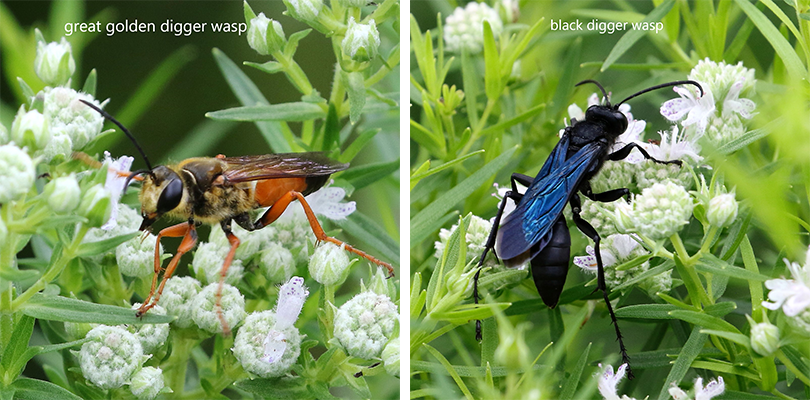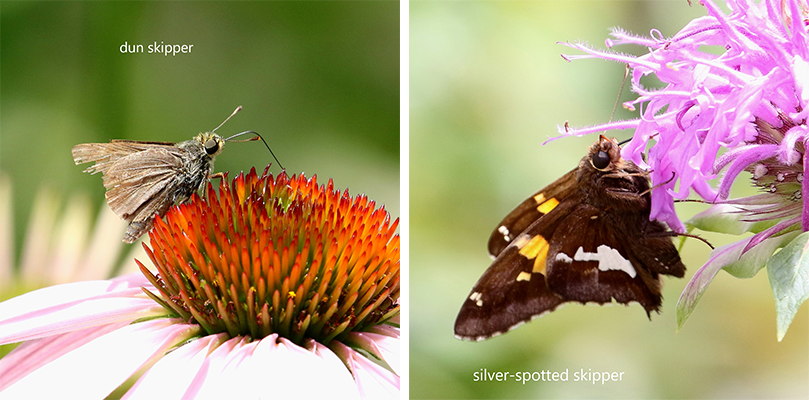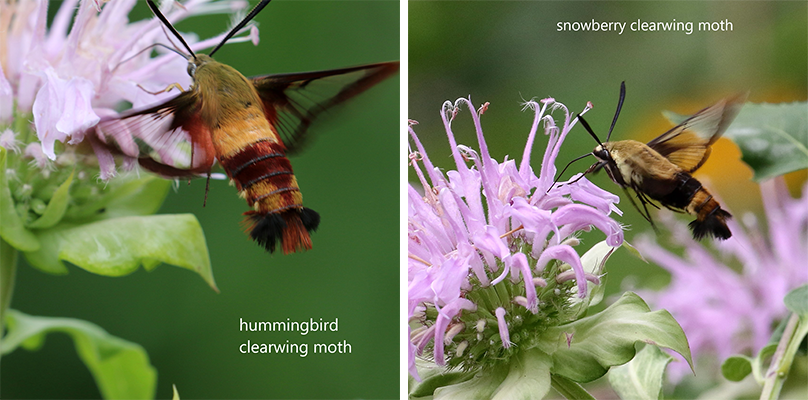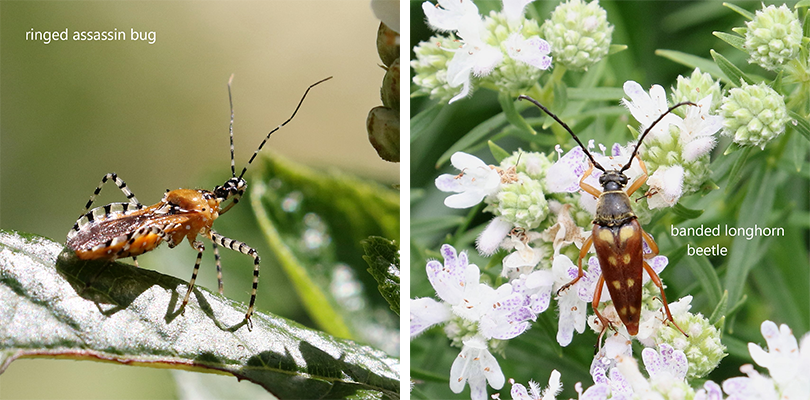Pollinator Garden Insect Survey
Article by David Forsyth
All photos by David Forsyth
NH Audubon established a pollinator garden at the McLane Center in the fall of 2018 which, with the help of many volunteers, has flourished. Plans are proceeding to start a substantially larger pollinator meadow at McLane in 2021. In order to establish a base line with which to understand how the insect population changes when the new pollinator meadow has been developed, I volunteered to conduct a photographic survey of insects present in the current garden.
The survey procedure was to visit the garden about every other week during midday, taking photos of any and all insects whether or not they are pollinators. After processing the photos, I analyzed them with a mobile phone app to establish a tentative identification. Some insects have a very distinctive color pattern, form, and/or behavior that allows them to be identified at the species level, whereas others can only be narrowed down to the genus or family level. The insects are not being captured and mounted for microscopic identification, so some identifications will no doubt remain tentative. The photos will serve as an archive of observations, so what is currently a citizen science project could be used by an entomologist for further study.
From July through September, I photographed approximately 120 insect species. The survey focused on insects larger than five millimeters in length due both to the difficulty of detecting the smaller ones and of photographing them adequately. Bees are no doubt the most important pollinators and they are strongly represented in the garden, with 22 species counted. The most obvious bees were the honey bee, bumble bees (six species) and the eastern carpenter bee, but many smaller bees such as sweat bees and furrow bees were also present. In addition to the bees, 12 species of butterflies, 10 species of moths, and 21 species of wasps were noted. During flower visitation, these insects feed on nectar and carry out pollination. Among the 20 fly species observed, it is interesting to note that the seven distinct flower and hover flies observed from the Syrphidae family resemble and behave much like tiny bees. Additional insects observed included beetles, dragonflies, ants, grasshoppers, and a variety of other bugs, many of which carry out important pollination services.
While wanting to be objective about my observations, as a human observer I found some strikingly beautiful and some amazingly bizarre. For example, compare the photos below of the warmly colored European (or western) Honey Bee with its packet of pollen and pollen-flecked head and body with the Leaf-footed Bug. I’m not an entomologist, but I am willing to learn and enjoy doing it. To turn this fun activity into science requires a systematic approach and record-keeping.
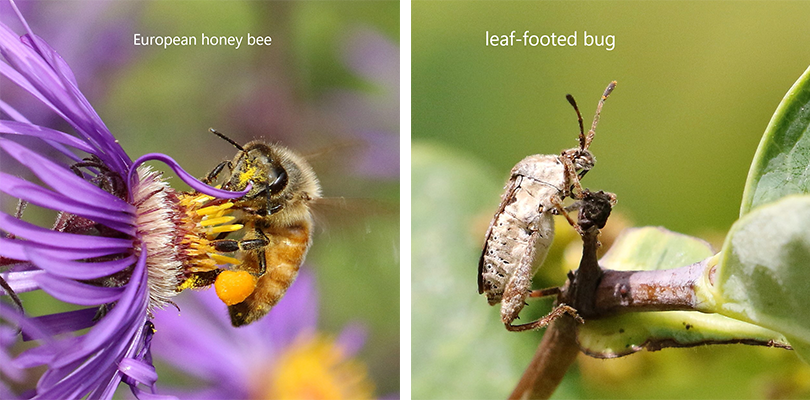
Some insects were much more easily identified than others. For example, the larger bees and wasps often have very distinctive forms and/or color patterns but smaller insects even in the bee family were much more difficult. Also, for some types of insects there are many species that may not have been studied thoroughly or catalogued in easily accessible literature. For example, what we call a daddy longlegs or harvestman is not one species but one of 6,500 known species of an estimated 10,000 species worldwide (and it is not an insect or spider but in its own order, Opiliones). As for bees, there are about 4,000 known species north of Mexico in North America. Thus, the smaller bees or daddy longlegs or other less well-defined insects are identified down to just the genus or in some cases family level.
There were distinct changes in what was present over time. Some of the larger wasps such as the dark and European paper wasps (see photo below) were present throughout my surveys but other species came and went during that time. I will continue this project into 2021 and by starting earlier in the season I hope to document species I may have missed because COVID-19 delayed last year’s start.
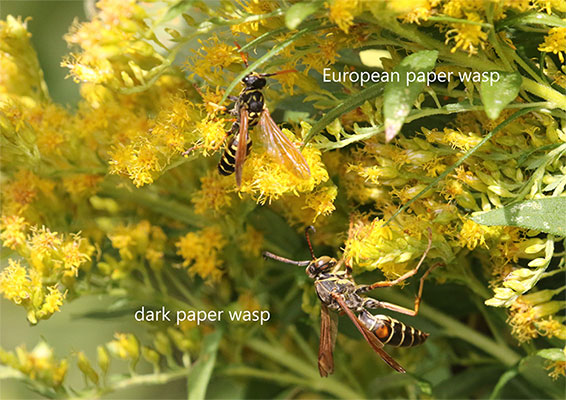
INSECTS OF NH AUDUBON’S MCLANE CENTER POLLINATOR GARDEN BEES. Bees from the Apidae family (honey bee, bumble bees, carpenter bees, and cuckoo bee) and Halictidae family (furrow and sweat bees) were the main types observed. There were a few from the Megachilidae (leaf cutter, resin and Osmia bees) and Andrenidae (miner bees) families. In all, 22 species were counted, although not all were actually identified down to the species level. Six species of bumble bee (Bombus) were tentatively identified; these are important and very active pollinators as they carry a pollen/nectar mix in a mass on their hind legs, as does the honey bee. Photos below show three bumble bee species: Common Eastern Bumble Bee, Tricolored Bumble Bee, and Perplexing Bumble Bee. The other two, the Half-black and Two-spotted Bumble Bees, are more difficult to distinguish between based on photos alone. Another important pollinator genus of bee is Osmia from the Megachilidae family, which carry pollen on stiff hairs on the bottom side of the abdomen. See the photos below of a green-colored example, as well as a green, metallic sweat bee from the Halictidae family. WASPS. Twenty-one species of wasp were noted in the study period. The most noticeable (large size), abundant, and appearing throughout the season were thread-waisted wasps (Sphecidae family), paper wasps (Vespidae Polistes), and digger wasps (Sphecidae Sphex). Although most wasps are meat-eaters, many also visit flowers for nectar, but are not important pollinators because their smooth bodies do not have the hairs that collect pollen the way bees do. Nonetheless, substantial numbers of digger wasps especially were often swarming around flowers; photos of the large (20-35 mm) Great Golden Digger Wasp and Great Black Digger Wasp are shown below. MOTHS AND BUTTERFLIES. Moths and butterflies also visit flowers for their nectar, using long tongues to feed. Based on my visits, the small, rather plain (15-20 mm) Dun Skipper and Northern Broken-dash (also a skipper) were the most abundant butterflies in the McLane Center garden, appearing between mid-July and mid-August. The larger and more familiar butterflies were seen only occasionally: the Eastern Tiger Swallowtail was seen on only one visit in mid-July, a Monarch was seen in late August as well as a Monarch caterpillar, and the Spicebush Swallowtail was detected only as a caterpillar in late July and early August although it had been seen as a butterfly earlier than July. (Due to the restrictions imposed by the Covid-19 pandemic, my visits didn’t begin until July.) See the photos of two of the smaller butterflies, the Dun Skipper and Silver-spotted Skipper sampling nectar with their long tongues. In all, I observed 12 butterfly species. Ten different moths were found during the July-September period, half of them as caterpillars or chrysalis. The large Promethea Silkmoth, aka spicebush moth (Caliosamia promethea) was found on the garden’s spicebush plant as a chrysalis. Two species of clearwing moth hovered bee-like and moved quickly from flower to flower as they fed on nectar at the end of July and beginning of August. The Hummingbird Clearwing (25-30 mm) and Snowberry Clearwing (22-30 mm) are beautifully colored moths with large transparent areas in their wings (see photos below). FLIES. About 20 species of flies were detected in the garden, but the dark flies that are most similar-looking to the familiar cluster flies or house flies are difficult to identify with a high level of confidence based on photographs alone. However, the Syrphidae family of flower flies and hover flies are often colorful and distinctly patterned. They resemble small (typically about 10 mm or less) bees in both appearance and behavior as they move from flower to flower. These insects often have colorful common names as well, such as those shown in photos: Eastern Calligrapher, Transverse-banded Flower Fly and Long Hover Fly. BEETLES AND OTHER INSECTS. At least 28 other insects and spiders were seen in the garden, but many of these were not seen visiting the flowers. Nine beetles were identified and a number of them do visit the flowers, including the small (<5 mm) Tumbling Flower Beetle and Shining Flower Beetle that were found on flowers. Others include grasshopper, ant, midge, thrip, caddisfly, bug, spider, and daddy longlegs species. Two examples of this broad grouping are shown in photos below: Ringed Assassin Bug and Banded Longhorn Beetle.
All photos by David Forsyth
